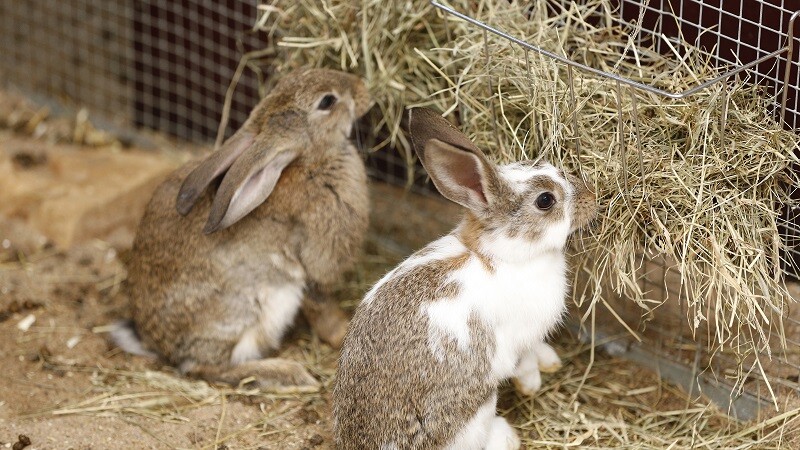

When it comes to eating, rabbits are probably more similar to cows, horses and guinea pigs. Rabbits are herbivores, they are designed to graze throughout the day, rather than ingest their daily ration in a single sitting. While it is normal for dogs and cats to eat once or twice a day, a rabbit that goes without food for a day may be seriously ill.
Unlike cattle, which have four stomachs to digest their food, rabbits are monogastric, meaning they have one stomach. The rabbit has the largest stomach in relation to his body size.
After the stomach, the next largest element of the digestive system in both rabbits is the cecum or hindgut. It contains a population of gut flora or natural bacteria that ferment the high-fiber diet these critters were designed to eat. If the population of normal flora is eliminated, it is impossible for rabbits to digest fiber properly. Ensuring a consistent throughput of good-quality fiber keeps the gut flora happy and healthy, and it is vital for maintaining health.
Both rabbits pass soft, mucus-covered fecal pellets called cecotropes, which they proceed to eat. Cecotropes are a critical source of vitamins, minerals and nutrients—and ensure that the gut is repopulated with healthy flora. Rabbits normally remove these directly from their bottom by grooming. It is an important distinction to make, because while it might be acceptable to discourage a dog or cat from eating excrement, rabbits and guinea pigs should be permitted to do so.
When it comes to water, rabbits are heavy drinkers, consuming more water per pound of body weight than any other mammal. An average adult rabbit consumes approximately 1.6 to 5 ounces (50 to 150 ml) of water per 2.2 pounds (1 kilogram) per day. Rabbits that are hungry or bored will drink even more. For this reason it is vital to provide fresh drinking water daily.
Herbivore teeth are designed for grinding. In this way, rabbit teeth have evolved to grind down fibrous vegetation, such as grasses and plants. Rabbits may move their jaws more than 120 times a minute when eating. In order to cope with this constant wear, the teeth of rabbits are open-rooted, allowing them to grow continuously. The upside is that the teeth won’t simply wear away with a high-fiber diet.
The downside is that if the diet is not high enough in fiber, the teeth will not wear down—in fact they may continue to grow, leading to abnormal wear, malocclusion (teeth don’t meet properly)—preventing effective grinding and causing the formation of spurs on the teeth and abscesses in the tooth roots and jaw.
If rabbits are not provided with enough grass or hay the teeth continue to grow unchecked, which can lead to serious dental disease. Dental disease in rabbits can manifest as inappetence, a lumpy or irregular feeling jaw, excessive salivation (“slobbers”) and abscesses around the face, particularly in the region of the cheeks and eyes.
The majority of your rabbit’s diet (around 80 percent) should consist of hay and grass, with the rest made up of vegetables (10 to 15 percent), then pellets and fruits.
If your rabbit already enjoys a diet like this, you are likely to have happy, healthy, long-lived rabbits . If not, you can take steps to change the diet, but it is important to introduce new foods slowly to ensure that your rabbits’ gut can adjust. When acquiring new rabbits, always find out about the previous diet and replicate this as closely as possible while gradually introducing new foods.
 Contact Jaguza Support
Contact Jaguza Support